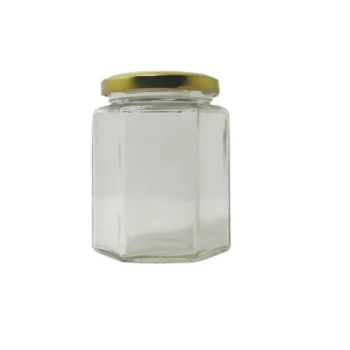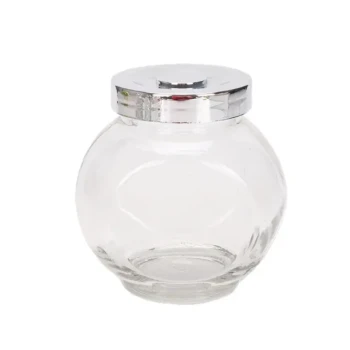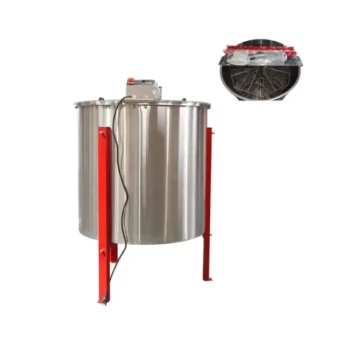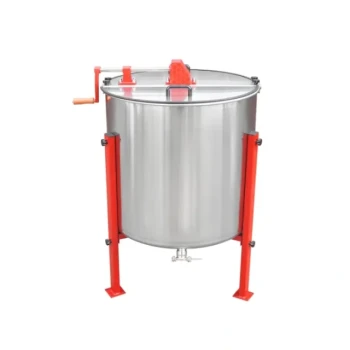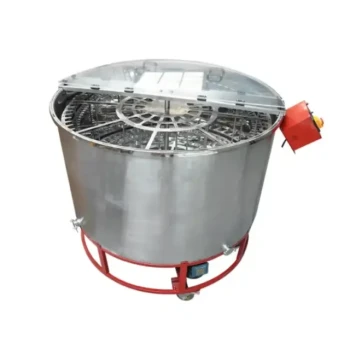For Warre hives, honey processing is a straightforward "crush and strain" method that leverages simple tools like mason jars. You begin by harvesting the honey-filled top bars, cutting the comb away, crushing it inside a jar or bucket, and then allowing the honey to drain from the wax through a filter.
The crush and strain method is not a workaround; it is the standard and most logical approach for the natural, foundationless combs built in a Warre hive. It trades the reusability of the comb for simplicity and an extremely low investment in equipment.
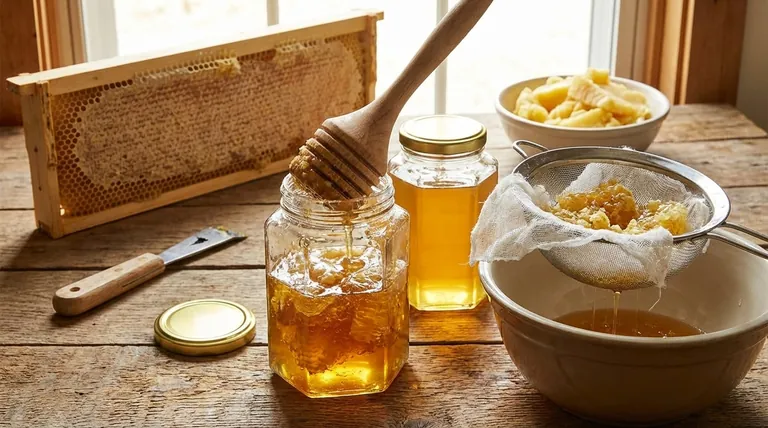
The Guiding Principle: Working with Natural Comb
The design of a Warre hive encourages bees to build their own comb naturally, hanging down from a simple top bar. This comb lacks the reinforced foundation and rigid wooden frame found in a Langstroth hive.
Because this natural comb is fragile, it cannot withstand the centrifugal force of a standard honey extractor. Therefore, the only practical way to separate the honey from the wax is to break the comb structure apart entirely.
Step 1: Harvest the Combs from the Hive
First, you must remove the honey-filled box (the "super") from the top of the hive.
The box is then flipped upside down, so the top bars are on the bottom and the open ends of the comb are facing up.
Using a hive tool or knife, cut the attachments where the bees have joined the combs to the sides of the box. This frees the individual bars, allowing you to lift them out one by one.
Step 2: Crush the Comb
This is where the mason jar comes into play. For a small harvest, this is a perfectly effective tool.
Cut the comb from the top bar, letting it fall into a large, clean mason jar or a food-grade bucket.
Using a clean potato masher, a large spoon, or even your hands (with gloves), crush the comb thoroughly. The goal is to break open every wax cell that contains honey.
Step 3: Strain the Honey from the Wax
Once the comb is crushed into a slurry of honey and wax, you need to separate the two.
Place a sieve, strainer, or multiple layers of cheesecloth over a clean jar or bucket. Pour the honey-wax slurry into the strainer.
Gravity will do most of the work. Let the setup sit for several hours (or overnight in a warm room) to allow all the honey to drip through the filter, leaving the beeswax behind.
Understanding the Trade-offs
The crush and strain method is elegant in its simplicity, but it's important to understand what you gain and what you give up compared to centrifugal extraction.
Advantage: Simplicity and Low Cost
This method requires minimal specialized equipment. You do not need an expensive honey extractor, heated uncapping knives, or other dedicated processing tools common in Langstroth beekeeping.
For the hobbyist with one or two hives, this makes harvesting honey highly accessible and affordable.
Disadvantage: The Comb is Sacrificed
The primary trade-off is that the beeswax comb is destroyed in the process. Bees expend a tremendous amount of energy to produce wax; it is estimated they consume 6-8 pounds of honey to create just one pound of wax.
Because the comb is not returned to the hive, the bees must rebuild it from scratch on the new top bars. This energy could have otherwise been used to produce more honey.
Alternative for Scale: The Fruit Press
If you are harvesting from several hives, crushing comb in mason jars becomes tedious.
The next logical step up is a stainless steel fruit press. You simply load the crushed comb into the press and turn a handle, which applies significant pressure to squeeze the honey out much more efficiently. This can process a large volume of comb quickly.
Making the Right Choice for Your Goal
The crush and strain method is fundamentally aligned with the philosophy of Warre beekeeping. Your decision on which tools to use depends entirely on the scale of your operation.
- If your primary focus is a small, personal harvest: The mason jar method is simple, effective, and requires no investment.
- If your primary focus is processing a larger harvest (more than 10-15 lbs): A fruit press offers a significant increase in efficiency over crushing by hand.
- If your primary focus is maximizing honey yield over many seasons: Be aware that sacrificing comb means bees spend more energy on rebuilding wax and less on foraging for nectar.
This method perfectly complements the low-intervention nature of a Warre hive, allowing you to process a pure, raw honey harvest with minimal fuss.
Summary Table:
| Step | Key Action | Tools Needed |
|---|---|---|
| 1. Harvest | Remove honey-filled top bars from the super | Hive tool, knife |
| 2. Crush | Cut comb into a mason jar and crush thoroughly | Mason jar, potato masher/spoon |
| 3. Strain | Filter honey from wax using a sieve or cheesecloth | Sieve, cheesecloth, clean jar |
Ready to streamline your honey harvest? As a trusted supplier for commercial apiaries and distributors, HONESTBEE provides durable beekeeping equipment designed for efficiency. Whether you're scaling up with a fruit press or need reliable tools for your operation, our wholesale-focused solutions help you maximize yield. Contact our team today to discuss your needs!
Visual Guide

Related Products
- Hexagonal Glass Honey Jars with Metal Lug Caps Elegant Versatile Packaging
- Classic Drum Shaped Glass Honey Jar with Airtight Lid
- Inverted Squeezable Honey Jar with No Drip Flip Top Cap for Easy Pouring
- Classic Honey Bear Jars with Flip Top Dispensing Cap for Liquid Sweeteners
- Plastic Honey Gate Spout with Wing Nut for Beekeeping Honey Bucket
People Also Ask
- What are the common types of honey packaging? A Guide to Glass, Plastic, Pouches & Tins
- How many jars of honey do you get from a hive? Unlock Sustainable Harvesting Secrets
- What factors should be considered when choosing honey packaging? Optimize for Brand, Operations & Market
- What is the best way to jar honey? Preserve Quality with the Right Container
- How should honey be stored and packaged? Preserve Flavor & Quality with Proper Containers
